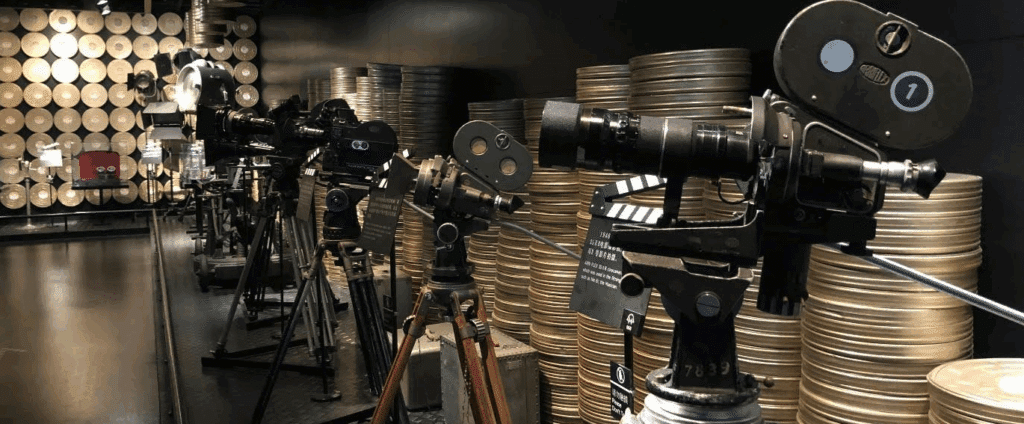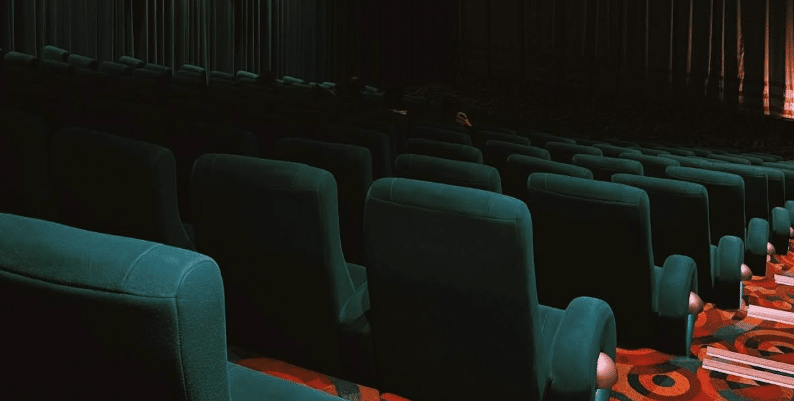
So, you’ve poured blood, sweat, tears and a whole load of time into developing your indie film? Your script is polished, your actors have given the performance of their lives, and the edit is finally locked. What’s next? Sending your film into big wide world.
Drum roll please…
This is where film distribution comes in!
We get it. Distribution can be a murky, overwhelming process, yet it is one of the most important stages in your filmmaking journey. You must know how film distribution works, how to navigate its ever-evolving landscape or it can mean the difference between your film finding an audience or sitting on a hard drive collecting virtual dust.

But before you crawl into a dark corner and cry, rejoice, because you’ve come to the right place. In today’s Celtx blog, we’ll break down what film distribution really means, how traditional and self-distribution compare, and even give you a step-by-step roadmap to get your own indie film distributed.
What are we waiting for?
Table of Contents
- What is Film Distribution?
- Traditional vs. Self-Distribution
- Steps to Get Your Film Distributed
- Deliverables You Need
- Helpful Tools and Platforms
- Conclusion
What is Film Distribution?
Film distribution is the process of making your film available to the public.
You could do this through theatrical releases, streaming platforms, television broadcasts, DVDs, or even festival screenings.
The distributer is essentially the intermediary between your film and the audience and oversee the logistics, marketing, and business deals needed to get your work seen.
The Role of a Distributer
Let’s take a closer look at exactly what the distributer does. Their responsibilities include:
- Pitching films to streaming platforms, TV channels, and international markets.
- Securing screenings at theaters or film festivals.
- Marketing films through trailers, posters, social media, and PR campaigns.
- Negotiating rights deals for digital, broadcast, and physical media.

Distributors also come in many shapes and sizes. Some are large companies like A24 and Netflix, while others are boutique firms focused on indie content.
Some are aggregators or sales agents who specialize in getting your film in front of decision-makers at platforms like Netflix, Hulu, or Amazon.
No distributor will do their work for free! In exchange for championing your film, they’ll take a percentage of your revenue, usually between 15-35% depending on the deal structure.
“Distribution in any other business is a cost that you incur. You know, in a trucking business, you eat it. In a film business, distribution is a profit center.” – Michael Douglas
What you need to remember is that not all distribution is created equal, which gives us a convenient segue into our next topic…
Traditional vs. Self-Distribution
Technology has led many advances in the film industry, and distribution has not been left behind! Filmmakers today face a key decision to either pursue traditional distribution or self-distribute. There are, of course, pros and cons to both.
What’s the difference between traditional and self-distribution? Let’s find out.
Traditional Distribution
Traditional distribution involves signing with a company that takes charge of releasing and marketing your film.
It often means securing a sales agent first to pitch your film to distributors, especially if you’re targeting a festival debut like Sundance, Tribeca, or the Toronto International Film Festival.
| Pros | Cons |
| Access to established networks and platforms | Less control over your film’s marketing, branding, and release strategy |
| Professional marketing and PR | Revenue splits tend to favor the distributor |
| Potential for theatrical release and award campaigns | It can be challenging to secure deals without a strong track record or festival buzz |

Self-Distribution
Self-distribution means you manage the release yourself, or with a small team. This could include using online aggregators like Filmhub or Quiver, renting theaters, promoting via social media, or even selling directly from your website.
| Pros | Cons |
| Full control over your film and revenue | Requires time, money, and marketing skills |
| Direct engagement with your target audience | Limited reach without platform partnerships |
| Faster release timelines | More difficult to secure press or media coverage |
As you can see, both directions have their merits. There is no ‘correct’ choice, and entirely depends on your goals, budget, and nature of your film.
Getting your film made is just half the journey. Celtx script writing and production software can help you stay organized from development through distribution.
Click here to sign up
Steps to Get Your Film Distributed
Okay, so we’ve explored the film distribution routes, but how do you actually get your film distributed now you’re in the post-production stage?
Here is our step-by-step guide on how to navigate the process, whether you decide to go down the traditional or self-distribution paths.
Step 1 | Know Your Audience
Before you even consider distribution, it’s essential you define who your movie is for. Is it a horror movie with mass appeal, a niche documentary for environmentalists, or a regional drama with a built-in community?
Understanding your audience will help with a whole host of your distribution tasks, including:
- Tailoring your festival and distribution strategy as a whole
- Crafting marketing materials that speak directly to your intended audience
- Deciding which platforms to target
When you know exactly who your film is for, you’ll set yourself off in the right direction, saving time and a whole lotta cash!Ideally, you should know who your audience are from the script and pre-production stages, but prior to distribution is the time when you need to have it nailed!

Research the festivals you’re applying to, especially if they charge submission fees. Talk to other filmmakers. Read online reviews of the fests. See how many years they have been around and what they have programmed before. – Jon Reiss (Think Outside the Box Office, 2009)
Step 3 | Seek a Sales Agent or Producer’s Representative
If your film has strong festival potential, a sales agent or producer’s rep can help broker deals with distributors. They will typically take a fee or percentage of your earnings, but they can open doors that are otherwise hard to access.
During your search for a sales agent or rep, keep your wits about you. Not all agents are reputable, so always research their track record first before reaching out to them for their services.
Step 4 | Approach Distributors
You absolutely don’t have to go through an agent or rep. Yes, you can approach distributors yourself!
Start by creating a pitch deck, screener link, and a short cover letter outlining the following:
- Your film’s genre and logline
- Your target audience
- Festival wins or press coverage so far
- Similar films and how yours stands out from all the rest
TOP TIP: Don’t jump straight to the larger firms. Start with smaller indie-friendly distributors and build from there.
Step 5 | Consider Aggregators
If traditional distribution isn’t an option (it isn’t right for every filmmaker, and that’s okay!), consider working with an aggregator!
These are companies that help place movies on platforms like Amazon, Tubi, Apple TV, or even Netflix (if your film qualifies).
Popular aggregators include:
- Filmhub (free, takes 20% of earnings)
- Quiver (flat fee)
Before signing on the dotted line, always make sure you read contracts carefully and retain your rights as the filmmaker.
Step 6 | Create a Marketing Campaign
Whether you go down the traditional or self-distribution routes, marketing is absolutely key to both! Your marketing strategy should include:
- A killer trailer and poster
- Accompanying social media content
- Press outreach and reviews
- Email newsletters and community engagement
And, of course, there are countless budget-friendly and even free tools to help you craft your movie’s marketing campaign! Check out tools like Canva, Mailchimp, and Buffer to streamline your efforts.

Deliverables You Need
Distributors, platforms and festivals all require a set of deliverables for movies to be eligible for distribution. Technical and promotional materials are a big part of this!
Let’s take a closer look at the deliverables you’ll need when submitting your movie:
Master Files
The most important file is the film itself, both in its entirety and trailer form.
For theatrical screenings you’ll need a Digital Cinema Package (DCP). This is a collection of digital files used to store and project films in movie theaters. DCPs must follow specific resolution and frame rate standards (e.g. 2K or 4K at 24fps). Audio needs to be around 5.1 surround sound, though stereo is sometimes accepted.
Your DCP should be formatted and transferred on a CRU drive or USB 3.0 drive.
Trailers should be in HD and ideally under two minutes.
Subtitles and Captions
Accessibility is extremely important, so make sure your subtitles are SRT or VVT files. Subtitles and captions are also key for international distribution.
You could also include subtitled versions of the full film in multiple language, but this is entirely optional.
Artwork and Promotional Materials
Think about your favorite movie. Can you remember the poster? What other advertising materials were used to market it? You’ll probably need these for your own film:
- Poster (in various sizes, both vertical and horizontal)
- Still images (in high-resolution)
Press kit (PDF file with synopsis, cast and crew bios, director’s statement, and production notes)

Legal and Business Documents
Yawn! Yes, we know this is deemed as the boring stuff, but it’s crucial to ensuring you are rewarded fairly for the work you’ve put into your project and keep all the rights!
You should consider:
- Copyright registration
- Chain of title (proof of rights ownership)
- Music cue sheet (for rights clearance)
- Errors and Omissions Insurance (often required by broadcasters)
Helpful Tools and Platforms
Navigating film distribution can be tricky, but it can be made much easier with the right tools and platforms. Here are our top recommendations that indie filmmakers swear by:
Aggregation and Distribution
- Filmhub (free-to-use, handling delivery and metadata of movies)
- Quiver (flat-fee distribution)
- Indie Rights (partners with filmmakers, especially for streaming)
Crowdfunding and Pre-Sales
- Seed&Spark (designed for indie films with built-in distribution support)
- Kickstarter/Indiegogo (raises awareness and builds an audience)
Project Management & Marketing
- Canva (design posters, promotion graphics, and social media assets)
- Mailchimp (build email lists for your audience)
- Later/Buffer (schedule and manage your film’s social media posts)
Sales and Rentals
- Vimeo OTT/Vimeo on Demand (sell or rent your movie directly)
- Gumroad (downloadable film sales and bundled packages)
- YouTube/Tubi/Amazon Prime (allow you to monetize your movie via ads or rentals)
Every filmmaker’s toolkit will look slightly different depending on their distribution plan. Some will opt for wide releases through Filmhub while others will target niche communities and sell directly to their target audience.
Only you know the right path for your movie! All that’s left to do is start walking.
Want to learn more?
Film distribution may be the last piece in the filmmaking puzzle, but it’s one of the most complex. Here are our top picks for resources you can use to make sure you’re in-the-know and ready to distribute your own movie to the masses:
- Think Outside the Box Office by Jon Reiss
- The Insider’s Guide to Independent Film Distribution by Stacey Parks
- Film Marketing and Distribution: An Independent Filmmaker’s Guide by Jonathan Sadler

Conclusion
Film distribution may seem overwhelming, but with the right knowledge and strategy, it’s a process you can master. The key is preparation, persistence, and a deep understanding of your film’s value.
Start by clearly identifying your audience and your goals. Then map out your ideal path, from festivals and agents to aggregators and direct sales. Equip yourself with strong deliverables, build a community around your film, and use the digital tools available to today’s filmmakers.
In today’s rapidly evolving media landscape, indie filmmakers have more power than ever to connect with audiences around the world. By understanding how distribution works, and staying nimble and informed, you can make sure your film doesn’t just get made but truly gets seen.
No matter how you plan to distribute your film,
start with a production process that sets you up for success.
Plan your next project with Celtx.
Up Next:

How to Sell a Movie Script: A Screenwriter’s Guide
Whether you’re going indie or industry, here’s how filmmakers are successfully getting their work in front of paying audiences.
Click here to continue
